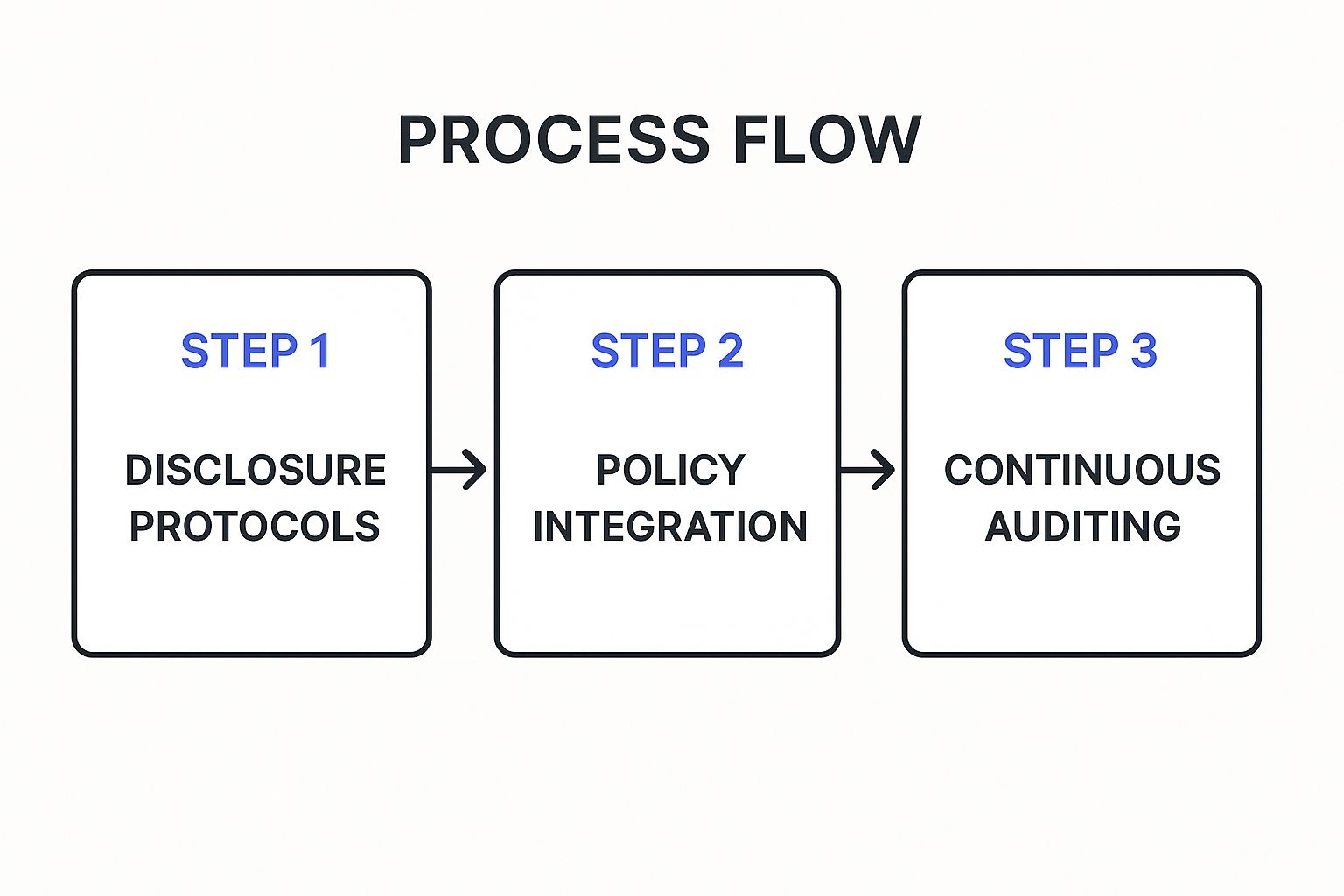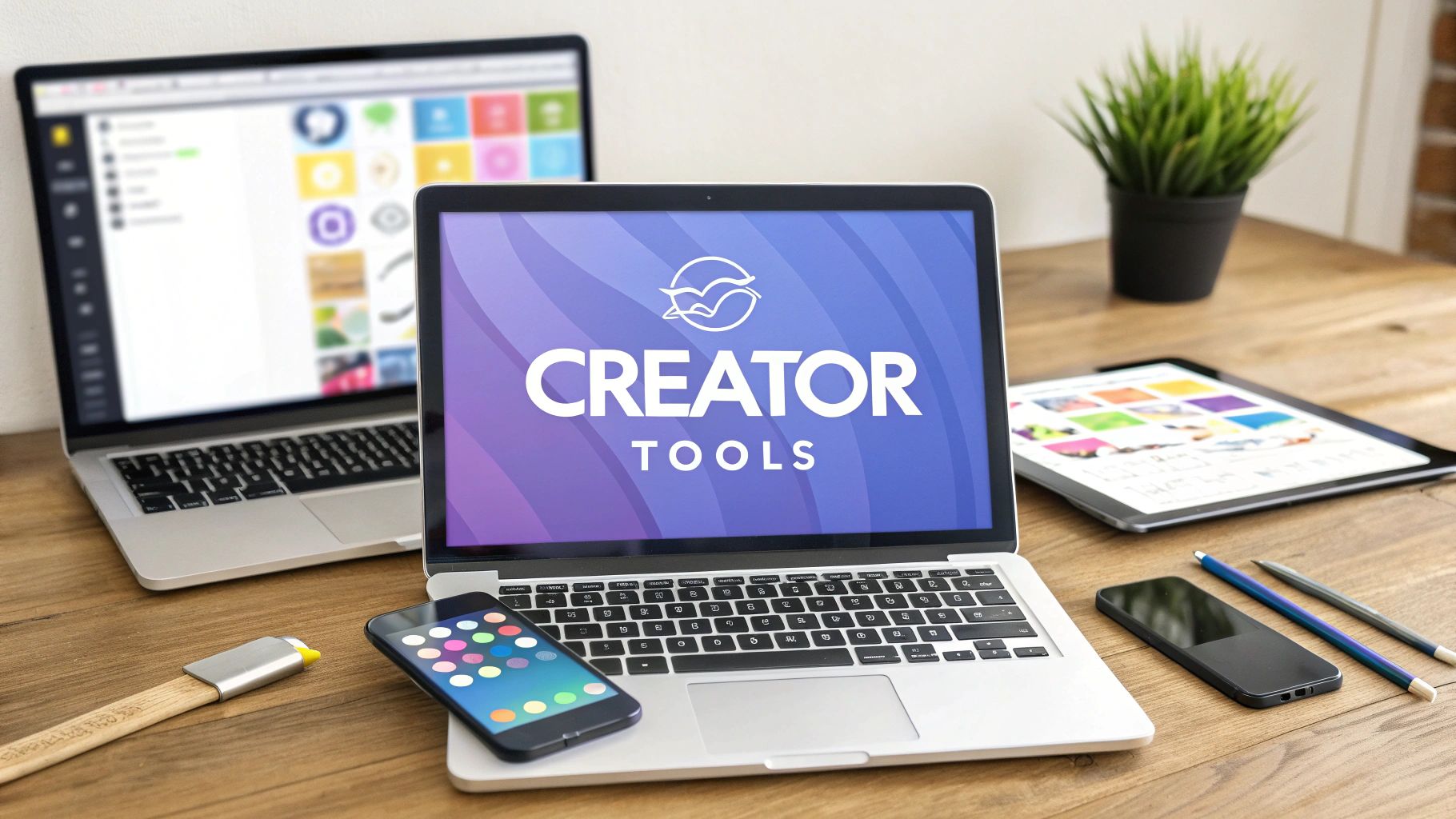When you hear "compliant synthetic influencer advertising," what should come to mind? It's simply the practice of using AI-generated characters to promote products, but with one crucial condition: you have to be completely upfront about it, following disclosure rules like those from the FTC. This approach marries the creative freedom of digital avatars with the non-negotiable legal and ethical need for absolute transparency with your audience.
The New Face of Influence and Why Compliance Matters
Picture a brand ambassador who’s always perfectly on-brand, never needs a day off, and can show up in a dozen campaigns at once. This isn't science fiction anymore; it’s the reality of synthetic influencers. These AI-driven personalities are quickly shifting from quirky novelties to serious players in the marketing world.
Think of them as a modern-day digital mascot, but with a fully developed personality. Each one is carefully crafted to connect with a very specific group of people. For brands, this offers a level of control and predictability that's simply out of reach with human influencers. You don't have to worry about off-brand posts, scheduling nightmares, or personal scandals.
The Rise of a New Marketing Channel
This isn't happening in a vacuum. The whole influencer marketing industry is exploding, with global spending reaching $32.55 billion, a huge leap from $24 billion just the year before. This growth is being driven by smarter, data-backed strategies and the increasing use of AI, which has created the perfect conditions for synthetic influencers to take off.
This is exactly why we need to talk about compliant synthetic influencer advertising. As more brands start working with these digital partners, they’re also entering a new world of rules and ethical responsibilities.
The real challenge isn’t just about making a cool AI character. It's about making sure every single post and interaction is built on trust. If you mislead your audience, even by accident, the damage to your brand's reputation can be permanent.
Why Compliance Is Not Optional
Following the rules isn’t just about ticking a legal box—it’s about protecting the trust you have with your customers. When people follow an influencer, they feel a connection. If they find out later that the personality they’ve come to like is not only an AI but that this was hidden from them, they'll feel betrayed.
That's why getting disclosure right is so important. We’ll get into the specifics of how to handle these new duties. For anyone just getting started, our guide on AI influencer marketing is a great place to learn how these digital personas are shaking things up for brands. By committing to transparency, you ensure your creative campaigns build strong, lasting relationships with customers and set you up for success.
Understanding Your Core Disclosure Obligations
Let's cut through the legal jargon. When you use a synthetic influencer to promote your brand, you're running an ad. That's it. And just like any other ad, you have to play by the rules set by bodies like the Federal Trade Commission (FTC). Their goal is simple: to make sure consumers aren't being duped.
Think of it as the basic rule of honesty in the digital marketplace. Ignoring these guidelines isn't just about risking a fine; it's about torching the trust you've worked so hard to build with your audience.
The Foundation of Disclosure: A Material Connection
At the very heart of the FTC’s rules is something they call a “material connection.” This is just a formal way of describing any relationship between you (the brand) and an influencer that might make a customer think twice about the endorsement.
This isn't just about cash for posts. It could be free products, a long-term partnership, or any other perk. With synthetic influencers, the connection is as direct as it gets: you literally are the influencer, or you paid to create or hire it for the sole purpose of promotion. That relationship is the "material connection," and you absolutely have to disclose it.
"If there’s a connection between an endorser and the marketer that consumers would not expect and it would affect how consumers evaluate the endorsement, that connection should be disclosed." - The Federal Trade Commission
This is the bedrock principle. If knowing about your relationship with the influencer would change how someone sees their "recommendation," you have to make that relationship public. No exceptions.
What “Clear and Conspicuous” Actually Means
The FTC insists that disclosures be clear and conspicuous. This is where a lot of brands stumble. It means more than just slapping a hashtag at the end of a caption. Your disclosure has to be practically impossible to miss and instantly understandable.
Think of a "Stop" sign. It's big, it's red, and it's placed right where you need to see it. Your disclosures need that same unmissable quality.
Here’s how to make sure you’re hitting the mark:
- Placement is Everything: Don't hide it. Burying your disclosure at the bottom of a long "see more" caption or in a sea of other hashtags is a major no-no. On a platform like Instagram, it needs to be visible in the first couple of lines, right upfront.
- Clarity is King: Use plain English. Forget jargon or vague terms. Simple and direct is always better. While hashtags like
#adand#sponsoredare a decent start, they only work if your audience knows what they mean. - Format for the Medium: A disclosure on a video needs to work even for someone who's just listening in the background. That means including it as text on the screen for a good chunk of time and mentioning it out loud in the audio.
Why #Ad Might Not Be Enough
Relying solely on #ad is a risky move, especially when you're working with AI influencers. The goal isn't just to check a box; it's to make sure no one feels misled.
For example, if #ad is the 15th hashtag in a long list, it's not conspicuous. If your audience is global, they might not even recognize what it signifies.
With synthetic influencers, you're actually pulling double duty on disclosure. You have to be upfront about two key things:
- The Commercial Relationship: You need to clearly state that the post is a paid advertisement.
- The Synthetic Nature: You also need to be transparent that the "person" promoting the product is an AI, not a real human.
If you only disclose the "ad" part, you're telling an incomplete story. A customer might see the ad and assume a real person is sharing their paid, but genuine, opinion. When they find out that "person" is a digital creation, they’ll feel tricked. That's a surefire way to damage your brand's credibility. The only safe and smart path is to be explicitly clear about both the advertisement and the AI.
How to Clearly Disclose Your AI Influencer
Everyone knows you have to disclose a paid partnership. That's standard practice. But what about when your influencer isn't even human? That's a whole new ballgame for compliant synthetic influencer advertising. This calls for a different kind of transparency—one that goes far beyond a simple hashtag to build real brand integrity.
The main idea is this: your audience should never feel tricked. Being transparent isn't a legal hoop to jump through; it's how you build a stronger connection with your customers. When you're upfront about using a synthetic influencer, you're inviting your audience to be part of the innovation with you. It turns something that could create distrust into a fascinating part of your brand’s story.
The Two Layers of Disclosure
Every campaign with an AI influencer has two distinct layers you need to disclose. You have to be crystal clear about both, or you risk confusing people and breaking their trust.
- The Commercial Relationship: This is your basic FTC requirement. You must clearly state that the content is a paid ad. Simple phrases like "Ad," "Sponsored," or "Paid Partnership" are a must.
- The Synthetic Nature: This is the new part of the equation. You have to tell your audience that the "person" they're looking at is a digital creation, an AI, or a virtual influencer.
Think of it like the nutrition label on a snack. You have to list the nuts for allergy warnings (that’s the ad disclosure), but you also need to mention if you used a new, lab-grown protein (that’s the AI disclosure). Your customers need both pieces of information to know exactly what they're consuming.
Best Practices for Placement and Wording
Where and how you place your disclosure is just as critical as what you say. The goal is to make it impossible to miss and easy to understand.
Here’s a quick look at some common methods for disclosing your AI influencer and how they stack up.
Disclosure Methods for Synthetic Influencers
| Disclosure Method | Where to Place It | Pros | Cons / Risks |
|---|---|---|---|
| Clear Hashtags | In the first two lines of the caption. | Simple to add and widely recognized by users. | Easy for users to miss if buried in other hashtags; terms can be unclear. |
| In-Video Text Overlay | On-screen for a good chunk of the video. | Very hard to miss and highly visible. | Can feel a bit intrusive if it’s not designed well. |
| Explicit Bio Statement | In the influencer's main profile bio. | Provides constant, upfront honesty for anyone visiting the profile. | Doesn't appear on individual posts when they're shared elsewhere. |
| Pinned Comment | As the very first comment on a post. | Guarantees anyone reading the comments will see it. | Not very effective for users who just scroll past without engaging. |
For the best results, don't just pick one—use a combination of these. A great post might include #VirtualInfluencer and #Ad right at the top of the caption, have a clear statement in the bio like "I'm a digital human created by Brand X," and use on-screen text for any video content. Our guide on how to create AI video ads has more tips on weaving these elements in naturally.
The infographic below breaks down a simple, three-step process for making these disclosures a routine part of your workflow.

By establishing protocols, making them official policy, and auditing your work, compliance becomes a natural reflex instead of a last-minute chore.
Real-World Wording Examples
When it comes to the actual words, just be direct. Don't use cute or vague language that might confuse the message.
Key Takeaway: Your disclosure needs to be so clear that someone scrolling quickly through their feed can instantly grasp two things: this is an ad, and this is an AI.
Here are a few phrases that get straight to the point:
- "As a virtual influencer, I’m excited to partner with..."
- "Checking out my new favorite product! (Disclosure: I'm a digital avatar & this is a paid ad)"
- "Powered by AI, designed by [Brand Name]. #Ad #AIinfluencer"
This level of honesty is quickly becoming what people expect. In fact, while 63% of marketers are now using AI in their campaigns, a whopping 75% of consumers say they want clear disclosure when AI is involved. You can explore more statistics about AI in influencer marketing to see just how important this is becoming.
At the end of the day, being upfront about using a synthetic influencer isn't just about following the rules—it's about respecting your audience and building a brand they know they can trust.
Navigating the Ethical Maze of AI Influencers

Simply following the legal rules for disclosure is just the starting point. If you want to be a leader in this space, you have to look beyond the letter of the law and start asking some tough ethical questions. When you create a synthetic influencer, you aren't just building a marketing tool; you're creating a digital personality that has a very real impact on its audience.
This is a big responsibility, one that goes far beyond a single campaign. Any brand stepping into this territory needs to think about the deeper implications. It means developing a strong internal ethical compass to guide every single decision, from how your AI looks to the words it "says."
The Unrealistic Standards Dilemma
Right out of the gate, one of the biggest ethical hurdles is the temptation to promote unrealistic beauty and lifestyle standards. We already see this problem with human influencers, who are often criticized for presenting a heavily filtered, unattainable version of reality. With AI, you can literally design a "perfect" person from the ground up—flawless skin, an idealized body, and a life with no real-world struggles.
While that level of control is appealing for a brand, it’s a double-edged sword. If your AI influencer reinforces impossible standards, you risk damaging the mental health and self-esteem of your audience, particularly younger followers. This is where having a solid ethical framework becomes non-negotiable.
Building a responsible AI influencer means making a conscious choice to design them with relatable, authentic, and diverse traits. The goal should be to connect with people, not create a digital ideal that makes them feel worse about themselves.
Guarding Against Misinformation and Misuse
Another major ethical red flag is the potential for your AI influencer to be misused. What happens if your carefully designed digital character is hijacked to spread false information or used for scams? This isn't just a far-fetched scenario. Concerns about deepfakes and AI-driven fraud are growing across the industry, with 28.4% of professionals pointing to it as a significant issue. This is exactly why regulators and brands are moving toward stricter standards for compliant synthetic influencer advertising. You can discover more expert insights about this trend and what it means for the future.
To protect your brand and your audience, you have to build safeguards around your creation. This means setting clear rules for how the influencer can be used and actively monitoring its presence online to catch any unauthorized impersonations or deepfakes.
Developing Your Ethical Framework
Thinking through these issues can't be an afterthought. Your brand needs a proactive, written ethical charter for any synthetic influencer you develop. Treat it as a living document that guides your team.
Here are a few key questions to get you started:
- Persona & Values: What values does our AI stand for? Do those values encourage positive and healthy interactions with our audience?
- Representation: Does our AI’s appearance and personality reflect and respect a diverse audience, or does it lean into tired stereotypes?
- Messaging Guardrails: What topics are off-limits for our AI? How do we guarantee its messaging is always truthful and constructive?
- Accountability: Who, specifically, is responsible for overseeing the AI’s actions and making sure it sticks to our ethical standards?
By tackling these ethical challenges directly, you’re doing more than just protecting your brand from risk. You're establishing yourself as a responsible player in an exciting new field. That foundation of trust will ultimately be far more valuable than the success of any single campaign, and it's the core of truly compliant synthetic influencer advertising.
Learning From Real AI Influencer Campaigns
Theory is great, but there's nothing like seeing it in action. To really get a handle on compliant synthetic influencer advertising, we need to look at what the pioneers are actually doing. The best lessons often come from dissecting real campaigns that are already out there.
By digging into how digital trendsetters like Lil Miquela and Lu do Magalu run their operations, we can see what works, what falls flat, and how they tackle the all-important job of disclosure. These examples are more than just interesting stories; they're practical blueprints that show us proven strategies and potential mistakes to sidestep.
Case Study: Lil Miquela’s Blend of Art and Commerce
If you've heard of any virtual influencer, it's probably Lil Miquela. She’s the creation of a firm called Brud and has become a global phenomenon, pulling in millions of followers and working with massive fashion houses like Prada, Chanel, and Calvin Klein. Her success is a masterclass in how to build a fictional character that a real audience genuinely connects with.
Right from the get-go, her public framing sets the stage for compliance. This screenshot from her Wikipedia page identifies her as a "fictional character and digital art project."
That framing is crucial. It immediately establishes that she isn't a real person, which goes a long way in managing what her audience expects.
Miquela’s creators have to walk a tricky line—they need to keep her character's story alive while also playing by the rules. For the most part, her team is good about using #ad or "paid partnership" tags on sponsored posts. That covers the first layer of disclosure: telling people it's an ad.
But what about the second layer—the fact that she's not real? That's handled a bit more creatively. It's baked right into her identity.
For anyone new to her world, the biggest clue is usually in her bio. In the past, it’s described her as a "robot" or a "change-seeking robot." Think about that for a second. That constant, upfront statement is a persistent reminder of her AI origins.
This approach is smart because it makes transparency part of her brand. Her digital nature isn't some fine print to be skimmed over; it’s a central part of her story. It turns a legal box-ticking exercise into an interesting character trait, creating a very unique kind of authenticity.
Case Study: Lu do Magalu’s Corporate Transparency
Now let's look at the other end of the spectrum. Meet Lu do Magalu, the virtual face of the Brazilian retail giant Magazine Luiza. Lu has been around since 2003, making her one of the oldest and most successful virtual influencers out there—with an audience that puts many human celebrities to shame. Her job is clear: she's a brand ambassador, product demonstrator, and customer guide.
Unlike Lil Miquela, there’s zero confusion about where Lu comes from or what she’s for. Her entire compliance strategy is built on being crystal clear.
- Explicit Connection: Her name itself—"Lu do Magalu"—literally means "Lu from Magalu." The brand connection is her entire identity.
- Clear Role: No one mistakes her for an independent creator giving unbiased reviews. She exists to represent Magazine Luiza, and her content, from unboxings to how-to guides, is unapologetically promotional.
- Constant Branding: Every single post is tied directly to the company. The "material connection" is so obvious that it’s impossible for a consumer to miss.
Lu’s massive success proves you don't always need a complex, dramatic backstory to win over an audience. Her appeal comes from being genuinely helpful, consistent, and completely upfront about who she is and what she does.
Key Takeaways for Your Brand
Both Miquela and Lu provide powerful, practical lessons for any brand thinking about jumping into this space. Their methods couldn't be more different, but they both succeed because they nail the same core principle: they manage audience expectations with clear and consistent communication.
From Lil Miquela, we learn that you can weave disclosure directly into your character’s narrative. And from Lu do Magalu, we learn that being direct and transparent can be just as powerful. The path you choose will depend on your brand and your goals, but these two examples prove that compliance and creativity don't just coexist—they have to.
Your Framework for a Compliant AI Influencer Strategy

Alright, we’ve covered the rules and the ethics. Now for the most important part: turning that knowledge into action. It's time to build a practical roadmap for your own compliant synthetic influencer advertising program. This framework will walk you through everything, from that first spark of an idea to a successful—and responsible—campaign launch.
Think of this as the blueprint for your digital ambassador. You wouldn't build a house without a solid plan, and you definitely shouldn't launch an AI influencer without a clear strategy. Following these steps ensures what you create is not just engaging, but also built on a foundation of trust and transparency from day one.
Step 1: Define Your Campaign Goals
Before you get lost in the fun of designing your AI's persona, you need to be crystal clear on what you’re trying to achieve. Is the goal to get your brand name out there? Drive sales for a specific product? Or maybe educate a whole new audience? The answers will shape every single decision that follows.
Get specific and set measurable objectives. A vague goal like "increase engagement" won't cut it. Instead, aim for something concrete, like "achieve a 5% engagement rate on Instagram Reels featuring our AI influencer over the next quarter." Clear goals like this give you a real yardstick to measure success.
Step 2: Create an Ethical Charter
This is your influencer’s constitution—a document that spells out the values, personality, and boundaries for your AI creation. This is where you tackle those tough questions we discussed earlier, making sure your influencer will be a positive force for your brand.
Your charter should answer a few key questions:
- What's our AI's core purpose? Is it here to entertain, inform, or inspire?
- What are its personality traits? Is it witty and sharp, or serious and nurturing?
- What topics are off-limits? Set clear guardrails now to avoid brand-damaging missteps later.
- How will we ensure it promotes inclusivity? Detail your commitment to representing diverse perspectives with respect.
This document becomes your team's north star, keeping everyone aligned and accountable as your AI influencer’s presence grows.
An ethical charter isn't just a protective measure; it’s a creative tool. It forces you to think deeply about the character you’re building, which often leads to a more compelling and authentic-feeling personality.
Step 3: Establish a Rock-Solid Disclosure Policy
Your disclosure policy needs to be non-negotiable and dead simple for your entire team to follow. This is where you formalize exactly how you’ll be transparent about sponsored posts and the AI identity of your influencer. It needs to be brutally clear.
Your policy must specify:
- Mandatory Wording: Define the exact phrases and hashtags you'll use (e.g., "#VirtualInfluencer," "#AI," or a statement like "I am a digital human").
- Required Placements: Detail where disclosures must appear. Think the first two lines of a caption, as permanent on-screen text in videos, and right in the profile bio.
- A Combination Approach: For maximum visibility, mandate using multiple methods at once—like a hashtag and a clear bio statement.
Making this a formal policy removes any guesswork. It also drives the kind of consistency that's vital for building long-term trust with your audience. For more ideas on weaving disclosures into video, check out our tips on creating engaging synthetic video ads.
Step 4: Monitor and Adapt Continuously
Launching your AI influencer is just the beginning of the journey. The final step is to build a system for ongoing monitoring and adaptation. You have to listen to audience feedback, track performance against your goals, and keep an eye out for any unauthorized use of your AI's likeness.
This is an active, hands-on process. Schedule regular check-ins to review comments, analyze engagement data, and scan for brand mentions. This feedback loop is what allows you to fine-tune your strategy, adjust your AI’s content, and make sure you stay compliant as your campaign—and the regulations—continue to evolve.
Got Questions About AI Influencers? You're Not Alone.
As marketers start dipping their toes into the world of virtual personalities, a lot of questions pop up. It’s a new space, after all. Let's walk through some of the most common ones so you can move forward with confidence.
What's the Real Difference Between a Human and AI Influencer Campaign?
It all boils down to control versus authenticity.
When you work with a synthetic influencer, you're in the driver's seat. You control the message, the look, even their "schedule"—they're available 24/7. This means you don't have to worry about a human partner going off-script or getting caught up in a personal scandal.
But that total control comes with a big responsibility. You're the one who has to build the influencer's personality and credibility from scratch. And you absolutely must be upfront that they aren't a real person. That's a huge compliance hurdle you just don't face with human influencers.
Are AI Influencers a Realistic Option for Small Businesses?
They definitely can be. It’s easy to look at a super-polished character like Lil Miquela and think it's only for brands with massive budgets. But the tech is getting cheaper and easier to use all the time.
Small businesses can start simple. Think basic virtual avatars or partnering with an agency that essentially "leases" out their virtual talent. No matter your budget, the first step is always the same: have a clear strategy. Make sure the virtual influencer you create or hire actually feels like a natural extension of your brand.
The most important investment isn't in photorealism—it's in authenticity. A simpler avatar with a well-defined, transparent personality can be far more effective than a complex one that feels disconnected from the brand's core values.
How Do I Even Measure ROI for a Synthetic Influencer?
You'll track many of the same things you already do with traditional influencer marketing:
- Engagement rates (likes, comments, shares)
- Audience reach
- Link clicks and conversions
- Overall brand sentiment
But there's an extra layer here. You also need to pay close attention to how people are reacting to the AI itself. Are they accepting of it? Do they trust it? You can figure this out by really digging into the comment sections and even running simple audience polls.
A great ROI isn't just about immediate sales. It’s a mix of hitting your campaign goals while building a reputation as a transparent, forward-thinking brand.
Ready to create high-performing ads with your own AI influencers? With Sprello, you can produce engaging, UGC-style video ads in minutes, no actors or complex editing needed. Start your free trial today!



